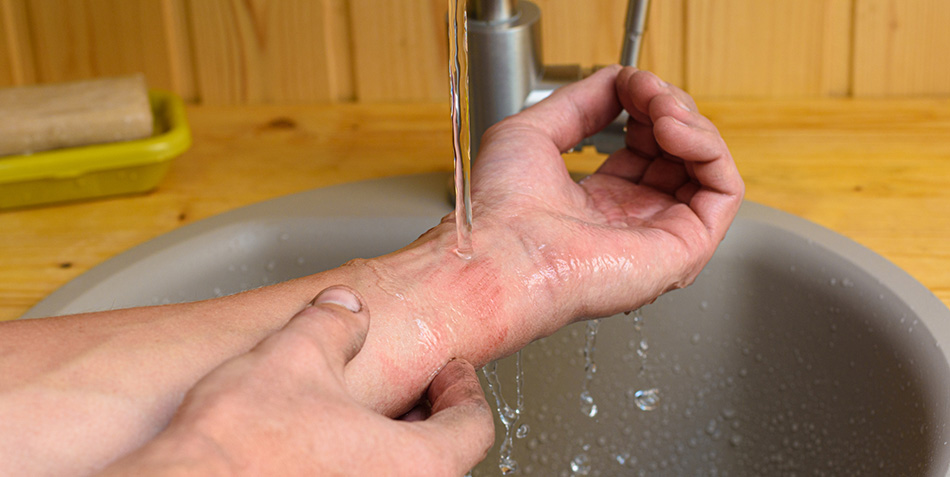
Minor burns can be treated with cool running water.
Summertime has many perks — longer days, outdoor activities and lots of sunshine, to name a few. But injuries due to burns often increase in the summer (especially around July Fourth) as people gather around campfires, enjoy fireworks, fire up grills and other common activities. In fact, more than one-third (37.5%) of hospital admissions for burn-related injuries occur between May and August, according to the Healthcare Cost and Utilization Project National Inpatient Sample.
Practicing summertime burn safety can help prevent them, but it's also important to be aware of the best way to treat a burn if one does occur. Let's look at common sources of summertime burns and the best treatment options to prevent further injury.
EIRMC operates the only Burn Center in Idaho, for both severe inpatient burn hospitalizations and outpatient burn care.
Common sources of summertime burns
While sunburns are among the most common types of burns, there are many more to be aware of. Educating yourself can help you prevent injury and know what to do in the event of a burn. In addition to sun exposure, other common sources of summertime burns are:
- Bonfires, campfires and fire pits
- Chemical burns, such as from pool chemicals
- Fireworks and sparklers
- Hot car handles, metal seatbelts and steering wheels
- Grill and grease burns
These burns can affect anyone, but children and older adults are especially at risk for injury. People who are intoxicated are also at a high risk for burns because alcohol reduces reaction time and coordination.
Five don'ts for burn treatment
Compared to the amount of time we spend around fire, most people don't know how to treat a burn. There are also many misconceptions about what to use if one occurs. Severe burns should always be treated at a hospital by a medical professional. When treating a mild burn at home, here are five things you should never do:
Butter
A common folk remedy is to put oil or butter on a burn. The belief is that a greasy substance will cool and soothe the burn. But there is no evidence that butter or any other greasy substance — mayonnaise, petroleum jelly, etc. — can heal a burn. Instead, they'll cause the wound to retain heat, slowing the healing process. Plus, bacteria in butter and other food sources can cause infection.
Honey
Honey has antibacterial and anti-inflammatory properties, so it's no surprise people have used it to treat burns throughout history. But you shouldn't use just any honey from your cupboard to treat a burn. However, dressings with medical-grade honey can be an effective treatment. Medical-grade honey (MGH) has been sterilized to ensure it can be used safely to treat wounds. MGH can be used for minor burns, but use with caution if you have a pollen allergy.
Mustard
There is no scientific evidence for using mustard to treat burns. In fact, it may actually irritate your skin further. After applying mustard, your skin may feel warm, but that doesn't mean it's healing your skin. The vinegar in mustard can lead to a reaction, worsen your burn or cause an infection and exacerbate your symptoms.
Toothpaste
Another misconception about burn treatment is that you should put toothpaste on it — but again, this can make it worse. Toothpaste can intensify the pain from the burn and increase the risk of infection and scarring. The ingredients in toothpaste do not have the healing properties to treat a burn. Instead, they can irritate wounds.
Ice
Although it sounds like common sense to put ice or ice cold water on a burn, this remedy should be skipped. Ice decreases blood flow to the affected area, which can reverse the healing process. It also numbs the pain from the burn, so you might not notice that the skin is getting too cold. This can lead to frostnip, a milder form of cold injury that precedes frostbite. Ice cold water can damage tissue and increase the risk of infection.
What is the best way to treat a burn?
The best burn treatment will depend on the type of burn you have. First, remove yourself or the injured person from the heat source. Remove any burned clothing — except clothing that is stuck to the burn — or jewelry.
Minor first-degree burns, or burns that only affect the outer layer of skin, can be treated with cool running water or a cold compress.
Do not apply creams or ointments, and do not pop burn blisters, as this can cause infection. Avoid adhesive bandages; they can stick to the skin and cause further damage. Instead, loosely cover the wound with a clean, dry, non-adhesive wrap or dressing.
Serious burns require emergency care. Seek medical attention immediately if you have any of the following symptoms:
- Fever
- Pus or drainage coming from the wound
- Excessive swelling or redness
- A burn that doesn't heal within two weeks
From bonfires to fireworks to grilling accidents, there are many burn hazards to be aware of this summer. Staying vigilant around hot surfaces and fire-related activities can reduce your risk of injury, but it's also important to treat burns immediately with proper first aid. Keep yourself and your loved ones safe this summer (and all year round) by practicing fire safety or even taking a first-aid class.
$webqFacilityNumber
Need a Physician?